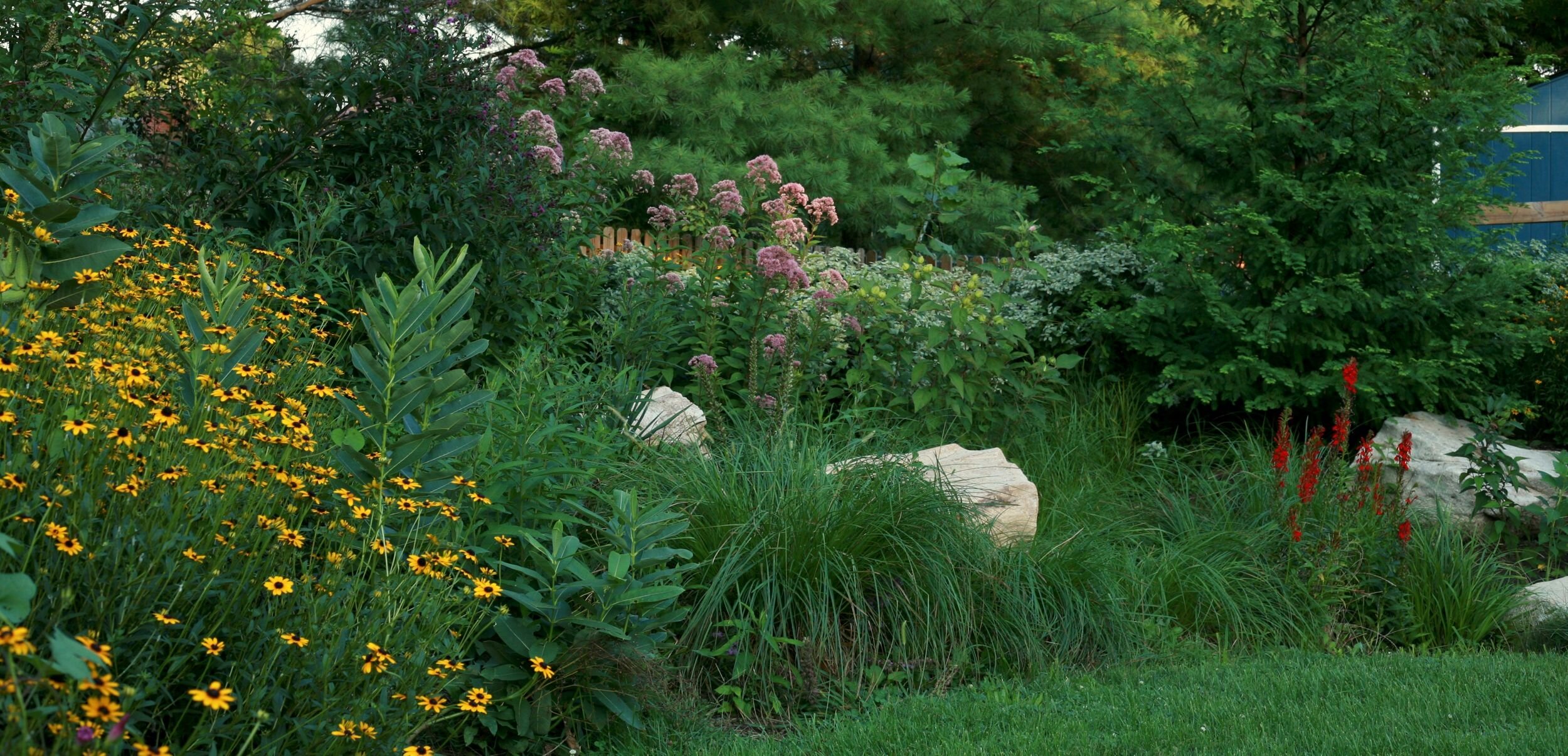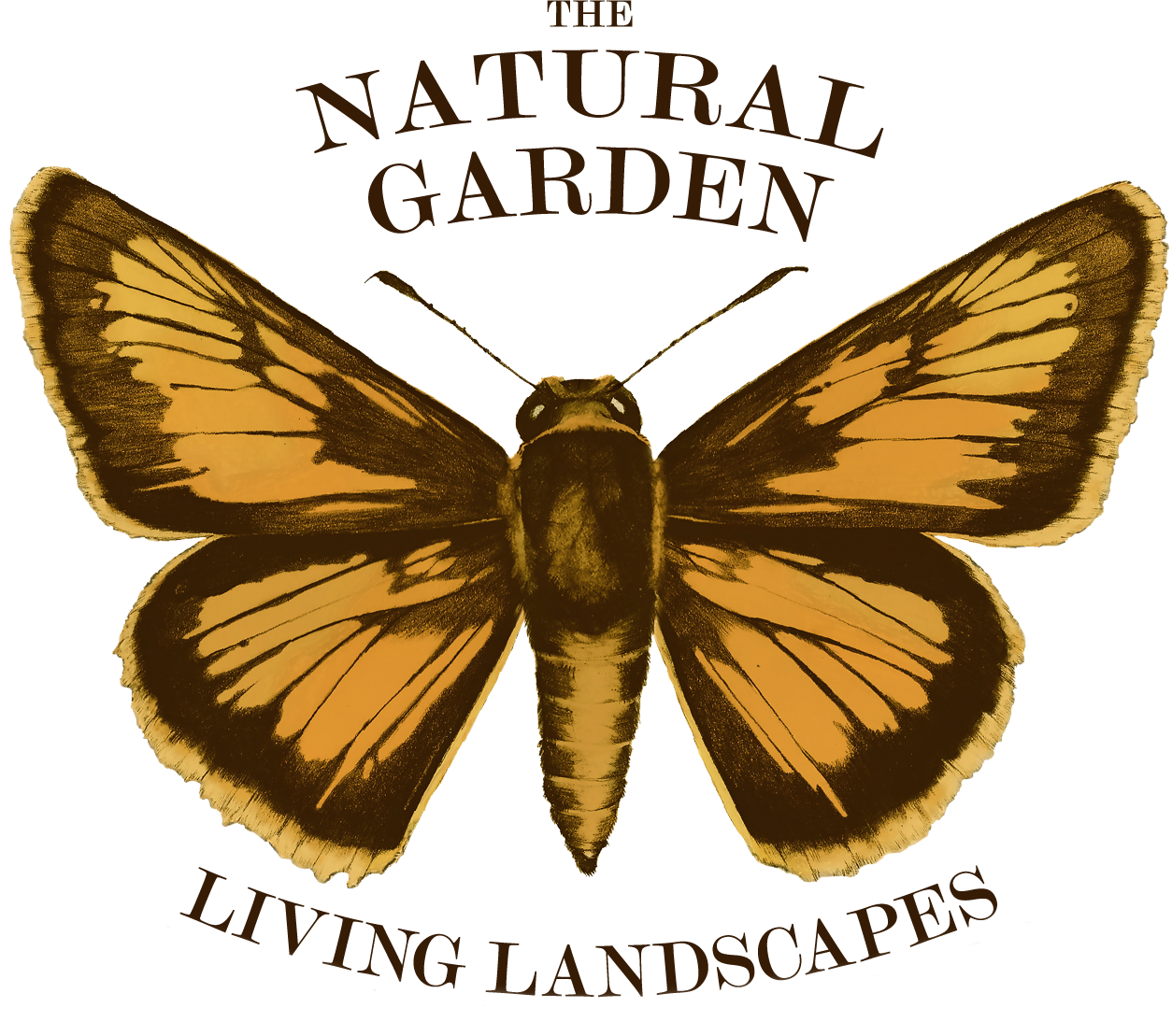
Living Landscape or Controlled Landscape?
Which garden design suits your preferred level of maintenance?
Design and maintenance both play a role in how your garden will develop and look over time. There’s a lower-maintenance approach to gardening we like to call “living landscapes” and a more intensive approach we call “controlled landscapes.” At the design level, we can help you choose plants that are well-suited for the aesthetic and maintenance level you prefer. In terms of maintenance, we offer garden coaching and several options for maintenance plans tailored for your design and preferences.
Living Landscapes
Controlled Landscapes
Comparing Living and Controlled Landscapes
Living Landscape: Cottage Garden
This living landscape changes from season to season and year to year. At the time this picture was taken, blooming yarrow was filling open areas in the garden, creating an English cottage garden look. Later, the yarrow was cut back and reduced in order to make room for a greater variety of species. While less than a controlled landscape, even a living landscape will need some seasonal maintenance, especially in the spring when weeds come in during April and May. As a living landscape ages, it will need less maintenance over time.
Controlled Landscape: Border Garden
This controlled border garden would need weekly to monthly maintenance to maintain its neat edge and to prevent native plants from intermingling over time. This will depend on the owner’s preferences and whether they are located in the city or country where there are more seeds. Seasonal pruning, transplanting, and occasional plant replacement will also be needed.
Alternatively, the homeowner could choose to allow the landscape to gradually evolve into a border meadow—with less maintenance.

Living Landscapes
We call our evolving plant landscapes “living landscapes” because they change over time like an unfolding drama.
As years go by, native plants will seed themselves in new spots throughout your garden in a dynamic, often dramatic process. We love this wilder, more natural look! We also like that it is less maintenance since the plants re-seed themselves and fill in gaps. We intend for our garden designs to blend seamlessly with our local ecology by planting with pollinators and other wildlife in mind, and using native species (not cultivars) when feasible to increase genetic diversity.
Maintaining a Living Landscape
A native plant landscape will look different from a landscape that uses cultivars and exotic species. Native species have greater genetic diversity, which benefits wildlife more. But they can be less predictable in a landscape. Variable factors such as the amount of rainfall in a given year, or different soil nutrients, can have an impact on the plant’s growth habit. Other factors include relationship to other nearby species (biodiversity), region and site conditions, year-by-year fluctuations in the seeding-off process, and fluctuations in temperature (exacerbated by the climate changing in recent years).
The level of maintenance required to maintain a living landscape will vary according to the microclimates, chosen plantings, and customer preferences for a certain aesthetic. Country gardens are likely to have more weed seeds carried in by wind and birds. Even a very natural-looking landscape will require a bit of care. Plan to spend 1-2 hours per week maintaining a low-maintenance landscape the size of a typical backyard during the first few years.
Controlled Landscapes
Our controlled landscapes are a good choice for those who want a more polished aesthetic.
It’s important to note that these landscapes will require more maintenance and may need to include cultivars of native plants rather than straight native species. We choose from a palette of native plants to avoid those with overly vigorous growth habits.
Note: We will never use invasive exotic species in our garden plans. When we use non-native plants, we prioritize edible, herbal, and medicinal plants or those that bring additional structure and order to the gardens.
We have learned from experience that the more we try to control native plants, the more work it will be. In some cases, maintaining a polished look could require 2-3 cutbacks on specific, vigorously-growing plants per year plus weeding as needed. Plants will need to be pruned, transplanted, or replaced regularly to maintain a specific look.
Maintaining a Controlled Landscape
We offer a range of ongoing maintenance plans to accommodate a spectrum of client needs. For more about our offerings, please contact our Service and Maintenance Manager, Jo Shipe. You may view the gallery below and learn from her how much time per week and per year each landscape requires. Some of these gardens have changed dramatically over the years depending on maintenance decisions and regular reworking. When planning your garden design, consider what you are able to maintain yourself or whether you plan to hire us to keep up the maintenance for you.
More Living Landscapes
Living Landscape:
Medium-size Meadow-Garden
This is one of our favorite low-to-medium-maintenance living landscapes. The homeowner-gardener chose to allow past-season grasses to provide a sculptural design element among the flowering Black-Eyed Susans and Meadow Petunias. The owner’s decision was the result of thoughtful attention rather than chance. Like an artist, she decides whether to make an adjustment or let a planting go.
Living Landscape: Large Pollinator Garden
This beautiful arrangement is one of our lower-maintenance designs. Because most of the 1-acre property is landscaped, however, the garden does take time to maintain. This picture was taken one year after initial planting with small plugs. The owners opted for less initial plant density in order to save money on installation. Where mulch is visible, additional seeds and plants will fill in to create a denser garden. Since gardening is the homeowners’ hobby, they spend a couple of hours each day nurturing it. For larger properties, a living landscape is manageable but still an investment. A more controlled landscape this size could quickly become unmanageable without substantial ongoing investment.
More Controlled Landscapes
Controlled Landscape:
Small Pollinator Garden
This controlled native plant landscape would need occasional cutbacks (1-2 times in spring) to prevent the perennials from growing too tall. Since the garden is small, less than a half hour per week would be sufficient to maintain this polished look—when combined with maintenance visits each year to check for plant growth and consistent appearance.
Controlled Landscape:
Large Pollinator Garden
Keeping plant species separated is a key difference between living landscapes and controlled landscapes. To preserve this stunning composition, this landscape would need substantial routine maintenance in the first 3-4 years until the plants filled in with greater density. After that, additional maintenance will be needed to preserve the attractive drifts rather than having the plants mix together.
In addition to regular weeding and refreshing the edges, some of these species will benefit by being cut back once or twice in spring so they don’t become too tall—especially in years with greater-than-average rainfall. Since Black-eyed Susans are excellent at seeding and planting themselves, they are likely to appear in unexpected spots in subsequent years. Since this landscape covers most of the yard, maintaining control will require a range of investment in time and money each year, depending on the homeowner’s aesthetic preference. Alternatively, the homeowner could allow the plantings to mix together and evolve into a suburban meadow.










































